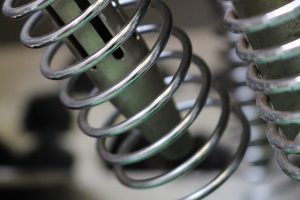
Coiled springs are used in a wide range of applications. Consisting of a helical piece of wound metal, such as stainless steel, they are designed to store mechanical energy. When exposed to a load, a coiled spring will store the load’s energy. To better understand how coiled springs work, however, you should familiarize yourself with Hook’s law.
What Is Hooke’s Law?
Hooke’s law is a principle stating that the deflection of a coiled spring is equal to the spring’s extension. It’s named after British physicist Robert Hook. In the 17th century, Hook discovered that the extension and deflection of coiled springs were equal, thus allowing him to come up with the formula for Hooke’s law.
Breaking Down the Formula
The formula for Hooke’s law is F = -kx. F represents the resulting force vector or the load to which a spring is exposed. k represents the spring constant or force constant, which is essentially the spring’s resistance to deformation. Finally, x represents the displacement vector or length of deformation.
There are two types of coiled springs: compression and extension. Compression springs become shorter when exposed to a load, whereas extension springs become longer when exposed to a load. Regardless, they both follow Hooke’s law. The distance from which a coiled spring extends or compresses from its equilibrium length is proportional to the spring’s deflection force.
Why Hooke’s Law Is Important
Hook’s law is important because it provides insight into how coiled springs will perform. It allows manufacturers to design springs that will extend or compress to a specific distance when exposed to a specific load. By taking into account the load to which a spring will be exposed, manufacturers can determine the distance that the spring will extend or compress.
Some coiled springs are naturally stiff. Other coiled springs are naturally soft. Soft springs are characterized by a higher spring constant than that of their stiff counterparts. Therefore, they deform more easily. Stiff springs, in comparison, have a lower spring constant. They can still deform, but stiff springs require a greater load or force.
In Conclusion
Coiled springs work by changing their equilibrium length when exposed to a load. Compression springs become shorter, whereas extension springs become longer. At the same time, the spring will push back with a deflection force. As noted by Hooke’s law, there’s a linear relationship between a coiled spring’s equilibrium length and the load or force. As the load or force increases, so will the spring’s equilibrium length.
